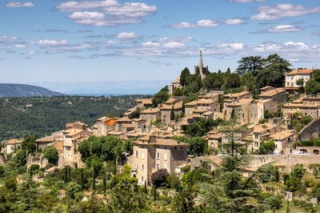Contact us
Send an email
Village of Vaucluse: Bonnieux
A quality of life dating from the Roman period

Bonnieux was an oppidum or fortified village inhabited since the Neolithic and Bronze Age. In the Gallo-Roman period, the village was situated at the foot of its present location, and the rich estates were numerous.
In the first century, the vast territory of Bonnieux was crossed by the Roman road from Cadiz to Milan, with relay under lights: it was one of the most important roads of Western Europe and the traffic was very dense. At the height of the Pont Julien, situated on the territory of Bonnieux, which was then called Bitrona, was the junction with the north-south subway by the Lourmarin valley.
In the Middle Ages for security reasons, the city was built around the elevated area which had been the Celto-Ligurian oppidum.
In 972, Bonnieux already had a fortress and walls.
In the 12th century, the "Templars" built the Chapel St Sauveur, which forms the Romanesque part of the upper church.
In the twelfth and fourteenth centuries, in the face of the danger of armed bands coming from the plain, the inhabitants took shelter in the shelter of the castle and the church, at the place called "Castellas", which belongs to the powerful family of Agoult . The town of the time is surrounded by ramparts including 4 gates and towers, of which there remain important vestiges.
Until 1312, Bonnieux would have been a commandery of the Templars. Around this date, the town became a pontifical land and remained a church until 1791. This belongs to the pontifical domain and makes it an enclave in the lands of the Comte de Provence, thus giving it a special place in history of the region. The city, which was sometimes forced by ecclesiastical dignitaries, then had 3,500 inhabitants and still enjoyed the important privileges granted to it by the Count of Toulouse Raimond in 1247. The coat of arms of the commune is the reflection of this prosperous period. Bonnieux became French by the annexation of the Comtat Venaissin by the Convention in 1793.
DISCOVER BONNIEUX:
Upper Church or Old Church. It is reached via a staircase of 86 steps in the shade of centenarian cedars. Orientation table at the Belvedere. New church (1870) contains four primitive nineteenth century figures from the Upper Church, representing scenes of the Passion. Remains of the Towers and ramparts of the XIIIth century. Hotel de Rouville from the 18th century (old town hall) Musée de la Boulangerie (04 90 75 88 34) The Pont Julien (An III av JC) in the plain, 5 km. The Philippe Tower, construction of an original at the end of the XIXth century. (not to be visited) The Forest of the Cedars in the Petit Luberon, 6 km
Sotheby's International Realty : Your specialist in luxury real estate in the Luberon and in Provence
The latest news





